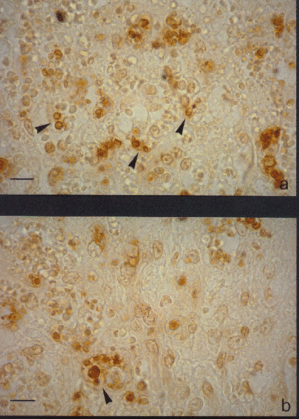1. INTRODUCTION Apoptosis was observed from invertebrates to lower and higher verterbrates and intervenes both in physiological and in pathological states such as normal cell turnover embryogenesis ...
PROTOCOL:•Deparaffinize and rehydrate slides:3 x 3´ Xylene3 x 2´ 100% ethanol1 x 2´ 95% 80% 70% ethanol (each)1 x 5´ 1x PBS•Microwave antigen retrieval:4 x 5´ in microwave (600 ml of 10mM NaCitrate pH ...
Fixation and pretreatment Dejelly albino embryos carefully in 2% Cystein (pH 7.8). Remove the vitellin membrane with two pairs of tweezers (or carefully pierce multiple times after fixation) F ...
I Destroy yeast1. Aspirate medium and wash cell in PBS.2. Incubate cells at 37oC for 5 min in non-diluted antibiotic-antimycotic.3. Incubate cells at 37oC for 5 min in trypsin. Spin th ...
DescriptionThis protocol is used in our lab to reduce the costs of the cell sorting with MACS reagents. The cell suspension obtained after this protocol contains 40-70% monocytes. This cell suspension ...
IntroductionObesity is a significant clinical problem that contributes to life-threatening diseases such as diabetes and atherosclerosis. With an increasing incidence of obesity worldwide rational str ...
1 Put mouse down 2 Wash skin by dipping mice into ETOH 3 Remove tumor and put into 5ml PBS containing Fungizone and Penstrep 4 Swirl around to rinse tumor and pour on to a sterile plate 5 Remove tumor ...
MaterialInstrumentsSolutions1 Curve Scissor50 ml tube 70% Etoh1 Straight ScissorEtoh Spray bottle1 Bone Scraper1 bottle of PBS2 Forceps (1 medium 1 fine)5 10 cm platesSacrifice AnimalsPlace mice in a ...
Blood Harvest・ Anesthetize mice with 50ml of Xylene-Ketamine(2:1) coctail・ Pin animal to a board (use distal extremities) supine・ Use 70% alcohol to moisten the abdomen and lower ...
OUTLINEIn order to avoid platelet activation all manipulations must be performed as quickly and as acurate as possible.Work on ice if possible! This protocol is based on differential centrifugation th ...
1. Dilute 2 ml of 4000 U/ml Collagenase D as follows: 1 ml into 9 ml HBSS/Ca++/Mg++ (=400U/ml) and 1 ml into 39 ml HBSS/Ca++/Mg++ (=100U/ml). Put on ice. 2. Place 5 ml of the 100U/ml solution in a 10 ...
Freezing Cells:Cells should be growing well or known to be in log phase Count collect and pellet cells in a 15mL test tube Resuspend in freezing media so that the concentration is no more than 5x10^6 ...
Take off Media Trypsinate with 1ml x2 Dulbecco A trypsin Add 7ml Media Pipette up and down to distribute cells throughout media (i.e. not clumped together) Add media to sterile falcon tube (15ml = 1 f ...
Freezing and Thawing cells Freezing It is best to freeze cells that are growing rapidly. With adherent cells it is easiest to set up 100 mm dishes give them fresh medium the day before you freeze them ...
For long term storage of myeloma cells hybridoma cells T cells and other mammalian cell lines in liquid nitrogen and restoring them in culture.FreezingPreparationCells are to be frozen in liquid nitro ...
1) Keep prepared solutions on ice.2) Determine total cell count of cells to be frozen. (e.g. 1 X 108 )3) Determine number of vials to be frozen. (e.g. 10 vials at 1 X 107 )4) Centrifuge cell suspensio ...
PurposeTo describe the preparation of a Master Cell BankSafetySee SP 09-001 for lab safety considerations for the cell culture lab.EquipmentLaminar Flow HoodFreezers -70oC or Rate-Controlled FreezerLi ...
Purpose: Cell lines are reactivated and grown to a count of 1 x 108 cells. The cells are pelleted and stored frozen at -80 degrees C prior to DNA extraction. Time required: 15-20 minutes to begin grow ...
1. Grow cells to subconfluence in a flask.2. Harvest as per normal and count.3. Spin down 5min 1.2K in benchtop. Resuspend at 1.0 X 106/ml in 10% DMSO in media. This is prepared from frozen aliquotss ...
Thaw vial quickly in 37� water. Caution - vial can explode. Transfer cells to sterile 15 mL centrifuge tube. Add 50 � warm FBS (fetal bovine serum heat inactivated) wait 1 minute. Add 100 � FBS wait 1 ...






